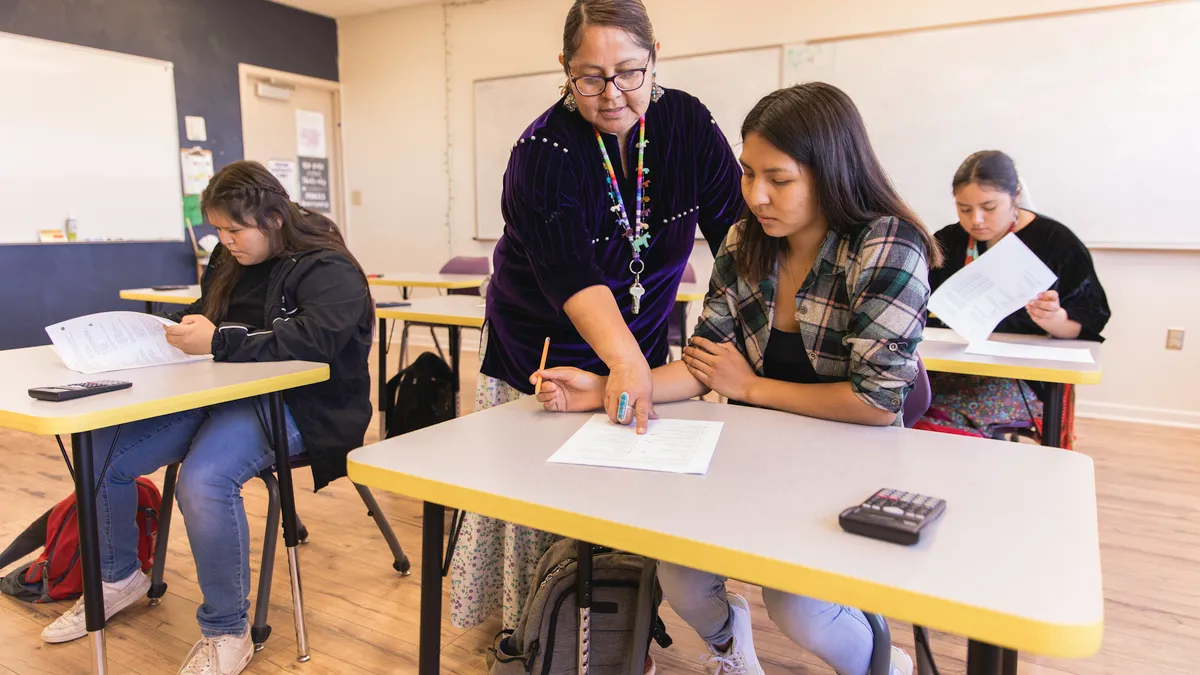Dive Brief:
- High school students from two minority populations report that the prospect of a teaching career is appealing because they want to build strong relationships with students and "make a difference" for incoming generations.
- These students of color and Indigenous students, interviewed for a report released Tuesday by Teach Plus and the Center for Black Educator Development, said they appreciate the unique impact that teachers from their populations have on students’ classroom experiences and futures.
- Low teacher pay, however, is a major deterrent for students of color from looking seriously into the teaching profession, the report said. A teacher’s level of agency in the classroom and the representation reflected in curriculum heavily shape students’ views about the profession.
Dive Insight:
The report comes as efforts to diversify the educator workforce are top of mind for school leaders nationwide.
The Teach Plus-CBED report, which interviewed 103 students of color and Indigenous students in high schools across 18 states, generally found students of color need schools to foster safe and accepting learning environments that appreciate and respect their cultural identities.
For some schools, however, it could be difficult to foster a culturally reflective environment as increased efforts through state legislation seek to censor curriculum considered “divisive topics” that often target discussions around race.
Additionally, school communities are seeing a rise in book bans, with the number of challenged titles jumping 33% between July 1, 2022 and June 31, 2023, according to PEN America, a free expression advocacy nonprofit. A disproportionate number of the books banned covered the experiences of marginalized communities — with 30% including characters of color and themes of race and racism and an additional 30% discussing LGBTQ+ identities.
“The students in our focus groups raised this political context as something that is weighing on their minds and those of their teachers,” the Teach Plus-CBED report said. “Students of color and Indigenous students are making decisions about the teaching profession based on what they observe of their teachers and in their schools right now.”
While the report indicates low teacher pay can deter prospective teachers of color, it may already be driving current educators of color out of the profession. A September RAND survey found, for instance, Black teachers were more likely than White educators to cite low pay as a driving factor when considering leaving their jobs — at 72% versus 57%.
For state and federal policymakers, Teach Plus and CBED recommend increasing teacher pay — particularly in states where wages are the lowest — in addition to investing in high-quality yet affordable educator preparation programs. The report also suggests that states encourage or require schools to instruct with culturally affirming curriculum.
“We as policymakers and systems leaders now have a unique opportunity to center the voices of students and communities as we build a sustainable educator pipeline and create school environments where diverse students and teachers thrive,” said Kira Orange Jones, CEO of Teach Plus, in a statement about the report.
The report also says districts should invest in efforts that support staff diversity and educate students about teaching career opportunities. To allocate funds equitably and support students of color, Teach Plus and CBED said districts should spend on dual enrollment, college test preparation and teacher apprenticeship programs.
Meanwhile, some higher education experts fear recruitment efforts to draw in more teachers of color could be hindered by the U.S. Supreme Court’s June decision overturning the use of race-conscious college admissions practices.







 Dive Awards
Dive Awards






